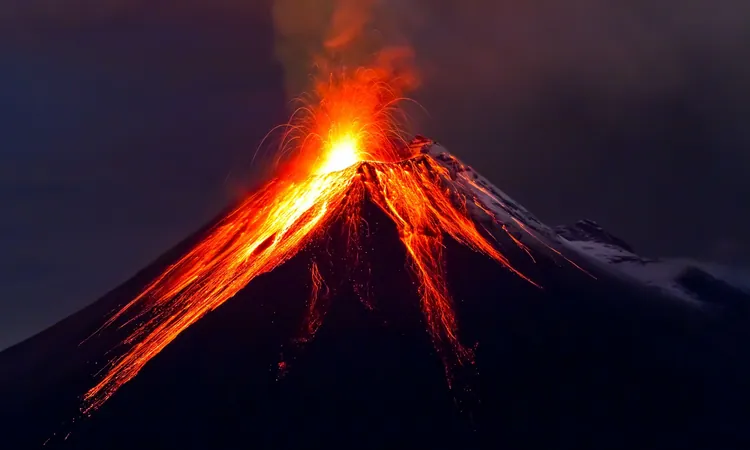
Unveiling the Mystery of Stealthy Volcanoes: Why They Erupt Without Warning!
2025-06-12
Author: Wei
The Enigma of Stealthy Volcanoes
Volcanoes are unpredictable beasts, with some playing by the rules and offering signs before they erupt. Typically, scientists rely on early warnings like ground deformation or a series of tremors, which indicate that magma and gas are building up underground. However, some volcanoes are stealthy, erupting seemingly out of nowhere!
Take Veniaminof, for instance—a glacier-cloaked giant nestled in Alaska's Aleutian Arc. A team from the University of Illinois has taken a deep dive into this volcano's surprising behavior and found clues that explain why it—and similar volcanoes—can erupt without any clear warning.
A Case Study: Veniaminof
Veniaminof is not your average volcano. Since 1993, it has erupted 13 times, yet it only offered sufficient warning signs twice. In a shocking moment, one eruption in 2021 went undetected until three days after it had started. Dr. Yuyu Li, the leading author of the study, highlights the risks these stealthy volcanoes pose, particularly since they often lie near bustling air routes or populated areas.
The Untold Characteristics of Stealthy Eruptions
Li's research identifies key factors that contribute to these silent eruptions. Low magma supply paired with warm host rock creates conditions that can conceal warning signs. In recent decades, Veniaminof has unleashed several VEI 3 eruptions, which can belch ash nine miles into the atmosphere, disrupt air travel, and threaten nearby communities—all without a credible warning!
Behind the Scenes: The Research
To crack the code, the researchers assessed Veniaminof's 2018 eruption, which was also stealthy. They gathered data over three summer seasons, creating models that simulated various volcanic conditions, adjusting factors like magma chamber size and magma flow rate.
Revealing Patterns: The Data Decoded
What the simulations revealed was intriguing. Rapid magma inflow into a larger chamber typically leads to visible signs like ground swelling, while small chambers can elicit more obvious warnings. Conversely, low magma flow in a small chamber often results in eruptions that strike without notice—just like Veniaminof.
The Impact of Temperature on Eruptions
The researchers also discovered how temperature plays a critical role. When magma resides in a chamber long enough, it warms the surrounding rock, reducing its likelihood to crack and send signals of impending eruptions. As the rock stays stable, earthquakes and surface movements—the usual warning signs—are minimized, allowing eruptions to occur in eerie silence.
Enhancing Monitoring Techniques
To address the potential risks of soundless eruptions, Li advocates for the implementation of high-precision monitoring tools such as borehole tiltmeters and strainmeters, alongside advanced techniques like infrasound and gas monitoring. Enhanced machine learning applications also hold promise for detecting subtle volcanic behavior.
The Future of Volcano Monitoring
In summary, scientists have identified the types of volcanoes most likely to erupt unexpectedly: those with small, warm magma chambers and slow magma movement. By combining real-time observations with sophisticated models, researchers hope to improve eruption forecasting.
Ultimately, these advancements could lead to better monitoring and prompt responses to protect communities from surprise eruptions, making the volcanic world just a bit more predictable!
Stay Informed!
If you found this intriguing, subscribe for more captivating articles, exclusive content, and the latest updates on volcanic research!

 Brasil (PT)
Brasil (PT)
 Canada (EN)
Canada (EN)
 Chile (ES)
Chile (ES)
 Česko (CS)
Česko (CS)
 대한민국 (KO)
대한민국 (KO)
 España (ES)
España (ES)
 France (FR)
France (FR)
 Hong Kong (EN)
Hong Kong (EN)
 Italia (IT)
Italia (IT)
 日本 (JA)
日本 (JA)
 Magyarország (HU)
Magyarország (HU)
 Norge (NO)
Norge (NO)
 Polska (PL)
Polska (PL)
 Schweiz (DE)
Schweiz (DE)
 Singapore (EN)
Singapore (EN)
 Sverige (SV)
Sverige (SV)
 Suomi (FI)
Suomi (FI)
 Türkiye (TR)
Türkiye (TR)
 الإمارات العربية المتحدة (AR)
الإمارات العربية المتحدة (AR)